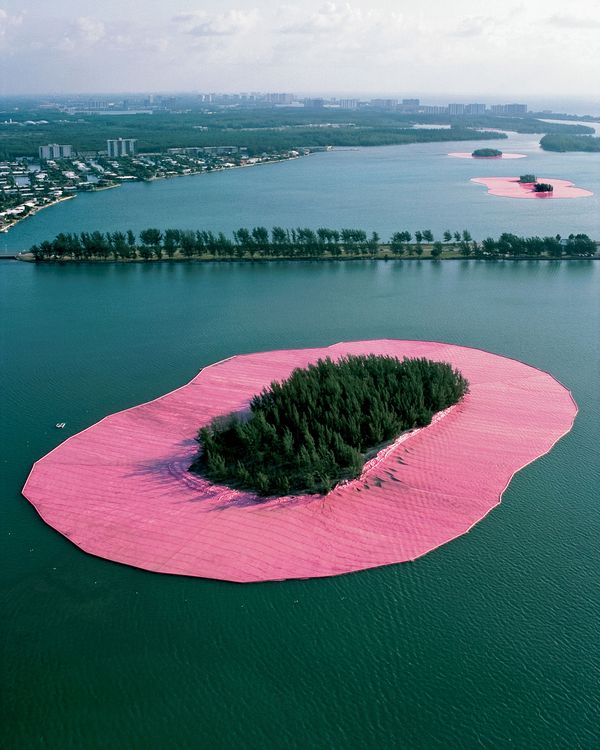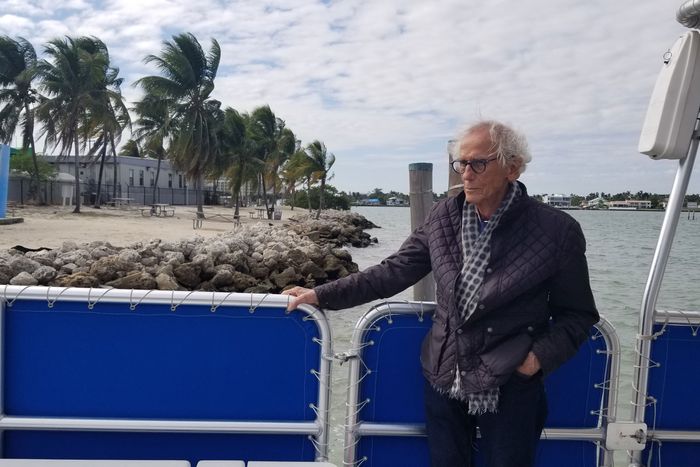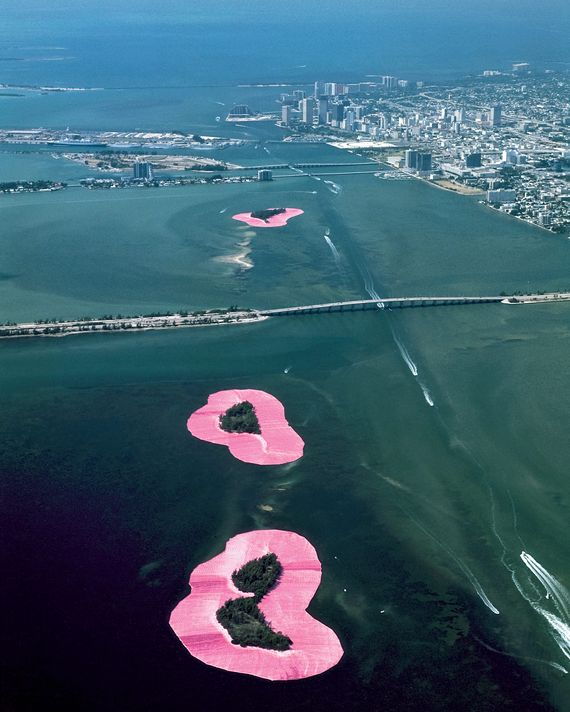
“Nothing, nothing, nothing,” Christo exclaimed, gesturing first toward the boats clustered in Pelican Harbor and then to high-rises crowding the shoreline, “There was nothing existing then.” It’s the opening day of Art Basel Miami Beach and we’re avoiding the convention center and its roving Champagne carts and deal-hunting VIPs to set sail in Biscayne Bay, cruising toward the several low islets he and his collaborator-wife, Jeanne-Claude, made famous 35 years ago as the “Surrounded Islands.” “As Jeanne-Claude would always say, ‘We return to the scene of the crime!’” Christo announces with delight. “That’s always part of it we like to see — the places change so much — that’s reality.”
As our boat approached the small sandy mass now dubbed “Pelican Island,” but back then simply called “No. 8,” he pointed to the aluminum dock and wooden roofs peeking out of the mangrove canopy: “There was nothing on there either. You couldn’t even walk; it was so dense.” Like almost every aspect of Miami in recent decades — structurally, economically, culturally — they’ve undergone a transformation. We look toward the glittering towers to the southwest, and with relish he adds, “Downtown Miami — nothing, nothing.”
These islands are dark thickets in the gleaming bay. Like “happy little accidents” populating Bob Ross’s landscapes, they’re remnants of a dredging project in the 1920s. Seeds of the invasive Australian pine found their way onto their man-made land and a haphazard ecosystem was formed. Christo and Jeanne-Claude noticed them while crossing the Venetian causeway — which connects the barrier island of Miami Beach to Miami proper — when they visited the area at the end of 1980. Almost immediately, they had an idea: to wreathe 11 of these non-naturally-occurring islands in 6-and-a-half million square feet of a woven tropical pink polypropylene, creating a wide, matlike margin of gently pulsing plastic, appearing for two weeks before being removed without a trace. They went to work, engaging the federal, state, and county’s bureaucratic machinery, creating sketches, hiring engineers, scientists, and lawyers. And they are nothing if not persistent (their 2005 The Gates project in Central Park was 26 years in the making). The effect of their installation in 1983 proved to be profound, remaining deeply embedded in the cultural psyche of a city that has since fashioned itself into a hub for international contemporary art.
Christo is 83 now, and Jeanne-Claude has been dead nine years. Pale-green waves flashed platinum as the breeze whipped Christo’s hair into a mock-heroic mane. Surveying the scene, everything is real, as he is fond of saying of his art — “the real sun, the real wet, the real dry, the real wind …” — except that we’ve come to see something that isn’t there: the site where his installation once was. As our boat circles “No. 8” Christo urged: “Use your imagination to see how much is 270 feet” — which is how far the fabric extended out into the water. We speculate different points in the distance it might have stretched, deciding our boat definitely would have been in the pink zone. Turning around the eastern side, Christo directs attention to the small complex of apartments, “I was so excited because this island was near houses — that building was the only one there — people were looking out their windows right onto the fabric!”
We docked at Pelican island, about four acres rising just above the water (one imagines for not much longer, given sea-level rise). Christo pauses to indicate the rocky shore a few feet below the new pier, “You see how abrasive! We had to install a heavier pink fabric first so the rocks wouldn’t tear the panels — ribbons of pink.” All of the islands were “rehabbed” in the early 1990s — Australian pines have been ripped out along with other “exotics” and replanted with native vegetation; serpentine concrete walkways and covered picnic areas have made it into a park. Looking around, we try to envision it as it was in 1983, Christo remembers: “It was so full of garbage, we removed 40 tons for this project.”
Tommy Salleh, the marina manager for Miami-Dade county overseeing our visit chimed in: “Some things never change. We remove about ten cubic yards of trash every month.” A Miami native, Salleh spoke with conviction about how deeply the memory of “Surrounded Islands” permeated his childhood: “You would see the photos of it everywhere — when you’d go to a doctor’s office or people’s houses. I think it put the image into people’s heads of what Miami could be in the future. What you see now with Art Basel was planted then.”
Alexandra Cunningham Cameron, newly appointed curator of contemporary design at the Cooper Hewitt and former creative director of Design Miami remembers that, too: “Everyone in the city had a ‘Surrounded Islands’ print in the house. My parents still have theirs.” As someone who’s worked closely with the city’s evolving cultural and political infrastructure over the past decade, she’s in awe of what they pulled off: “I can’t imagine what they dealt with in Miami at that time, honestly. It was truly a Wild West.” Currently on view at the Pérez Art Museum Miami is “Christo and Jeanne-Claude: Surrounded Islands 1980–1983” a “documentary exhibition” that aims to communicate that process with sketches, photographs, ephemera, and legal documents. “It gives you an idea,” Christo reassures, “in some ways it’s boring. You cannot substitute the project. But you learn how the project is done — these details, the engineering, how the fabric was sewn.”
Christo and Jeanne-Claude assembled these archives to be shown in cities where they were developing new pieces, to “sensitize” them to their vision, process, and to show no harm had been done. In the exhibition, you see many of the large-scale preparatory drawings and collages, the sales of which financed the project, along with photographs by Wolfgang Volz from 1980–1983. In the pictures, you see Christo and Jeanne-Claude talking to people — everywhere from committee rooms to shipyards — modeling the elegant pantomime of renaissance painting, alongside the many stages of installation, often from the air.
As the meticulous exhibition charts, the years of meetings, permits, and studies, are as much the “project” as the two weeks the “Surrounded Islands” actually existed — the artists maintain that through these arduous institutional and public negotiations the work gains its identity and dimension. The best way to appreciate what is special about their achievement is through the cycle of cinéma vérité films Albert and David Maysles made, which include Christo’s Valley Curtain (1974); Running Fence (1978); Islands (1986); Christo in Paris (1990), about the wrapping of the Pont Neuf; and Umbrellas (1994). Taken together, they constitute a masterpiece of 20th-century art — a collaboration between the perfectly calibrated sensibilities of Christo, Jeanne-Claude, and the Maysles. Christo described their goal “to translate the humanity of these projects, which is the gift and talent of Albert and David: a humanity that is impossible unless the camera is a witness, with no narration, to the reality of drama. It’s not repeatable.” Because their projects take decades of permissions and planning, they’re all intertwined, and the film is the ongoing process of several simultaneously. For instance, Islands intercuts the couple’s meetings with the Miami-Dade officials, discussions with Jacques Chirac in Paris, and with the parliament in Bonn about their work on wrapping the Reichstadt. Witnessing these vastly different styles of governmental power-brokering, and their ability to seamlessly engage them all, presents Christo and Jeanne-Claude as self-appointed diplomats for art.
Take the scene in the Maysles’ film: The Miami-Dade County commission had just voted down the project in a five-four split. No “Surrounded Islands.” The camera cuts to Jeanne-Claude and Christo in the lobby, warmly greeting the man leading the opposition to their project, Harvey Ruvin, then a Miami-Dade County commissioner, who worried about its effect on the local environment. “Why don’t we go eat something?” Jeanne-Claude suggests. The camera cuts to them all at a table, Ruvin asks them to explain why this is art. Christo describes his ambitions and the way he sees their projects as connecting to an older more communal form of art, “Today the man buys a work of art, closes it in his room, and no one can see it … People go in museums, confronted by objects and right away …” As he’s flagging, Jeanne-Claude interjects, “You will never catch any person waking up his wife and kids early morning and saying, ‘Let’s go if it’s still there!’ in a museum. But they will do that here. And there is a tenderness for such a fragile …” Ruvin is listening. He requests a sizable donation to the local government, which goes against the artists’ rules. Back in the municipal building, the couple strategizes with a lawyer, with Jeanne-Claude suggesting that the county could sell posters of the project as a way around making a financial contribution. Back in session, their lawyer announces that “Christo would like to offer 1,000 signed and numbered photographic images of the finished project. The county has a right to sell these images and the profits can be used for the preservation and enhancement of Biscayne Bay.” Just like that, the motion passes. Smiles all around.
These conversations about their art, whether with German politicians or Sonoma ranchers, are never condescending. From the films you see what gifted communicators they are. Talking with Christo, even as he tells you a story he’s certainly told thousands of times before, you can still feel his excitement because it’s the first time he’s told it to you — it’s the one-on-one of it, meeting you where you are, that drives him. This enabled the kinds of incredible projects they achieved, but also prefigured some of the most prominent forms of contemporary art today, which takes these kinds of intangible interactions as their subject — an influence they rarely get credit for. Conceptual artist Jill Magid is at the forefront of this vein, entangling herself in everything from Liverpool’s CCTV networks to the posthumous legacy of architect Luis Barragán. She explains that “permission is a material and changes the work’s consistency” — an ideal that can be directly linked to Christo and Jeanne-Claude’s example. Magid remembers the thrill of finding their precedent through the Maysles’ films: “The final works were clear and always spectacular, but it was the process to realize them that impressed me. Christo and Jeanne-Claude were able to impassion people — from local citizens to government officials — to engage their ideas, grant permissions, and actualize their vision.”
Unlike most canonical “land art” of the American West, which ideologically asserts a vast virgin wilderness in which to intervene, Christo and Jeanne-Claude bring a European’s sense of “landscape,” always placing their interventions in proximity to man-made structures. He says, “Our projects need to have human presence. We need to have a house, a pole, a road, to see how tall, how wide, how big. We cannot do a project somewhere in the forest and have no reference for the dimension of the work.” In the case of “Surrounded Islands,” the specific color emerges from Miami itself in both a perceptual and cultural sense.
Pink is the color of Miami, the city’s idea of itself that it sold to the world. Of course the effect of Christo and Jeanne-Claude’s pink fabric mimicked the naturally occurring intense sunsets, and Florida’s iconic flamingos, both the feathered and plastic varieties. It was a bit brighter than the pastel pink in the South Beach Art Deco district, which was beginning to be restored at the time, and a little more bubblegum than the hue adopted by the firm Arquitectonica in its first project, the Pink House, in 1981, a collaboration between Rem Koolhaas and Laurinda Spear. And a year after “Surrounded Islands” was realized, pink would go nationwide when the TV show Miami Vice, aired in 1984.
The artists had to experiment with how different shades of pink fabric would read from miles away. “You see, at first it was a very shy pink,” Christo says, “But to come here there is very thick air; this is why we needed to have this very saturated bright pink so that it would translate from a distance as a light pink. It’s about the specific light of the place. I adore the wetness, the air; it’s full of water.” Explaining the project at the time, he tried to convey the visual effect, that it would be painterly, “like marvelous water lilies; it’s my Monet.” The color’s artificiality was further enforced by the precise faceting of each island’s outline, held in place by hexagonal booms and thousands of underwater anchors. The procession of drawings at PAMM chart the rigorous geometry of all 11 islands, marrying straight lines with organic form.
The PAMM curator who organized the exhibition, René Morales, remembers being 8 years old when his father came home and enthusiastically loaded the family into the Oldsmobile to see “Surround Islands” — with that sense of urgency Jeanne-Claude knew people would have. “What I remember more than the project itself is my father’s excitement,” Morales says, “his sense of wonder, of something being not quite normal.”
The exhibition has been hugely popular, with about 2,500 people showing up to the opening to meet Christo. Reflecting on why PAMM mounted this exhibition in 2018, Morales says, “It affected the cultural memory of this place. It caused a whole city to pay attention to the same thing at once, creating a communally shared memory, a shared experience, which in turn creates a kind of community.” For this reason, the “Surrounded Island” archive, which this exhibition partly presents, should remain in Miami. Christo agrees, saying that it was a dream of Jeanne-Claude’s and his that the materials for these projects remain in the cities they occurred, “that is part of their story.” Morales is similarly passionate about the prospect of PAMM acquiring the remains of “Surrounded Islands,” though qualifying that it would be a long institutional process needing several patrons to underwrite.
Back on the boat, we leave island “No.8” for nearby islands “No. 9-10” which were wrapped together, honoring a barely visible sandbar running between then. “This was the last one to be finished, and the largest — look at how much fabric had to go between them!” he says. When asked the “meaning” of this gesture, and by extension of art itself, Christo replies, “There is no meaning except happening. This is total irrational freedom. They’re not justified by causes — no moral issue. Today, we are bombarded by the ‘goodness’ of things. These are inexplicable, capricious, worthless. That is really the greatness of art.” Riding back to shore with him in the early afternoon, there was the melancholy of what wasn’t there — yes, the pink of the project, but more powerfully of Jeanne-Claude. Watching the Maysles’ films, you see her as a genius of soft power, smoothing the massive egos of engineers and politicians and mobilizing whole armies of seamstresses, boat captains, and attorneys. I mentioned this to Christo, “Yes, the daughter of a French general. She was a very strong speaker, but she used a soft voice to manage things.” Without her particular gifts, the scale of these projects would be unthinkable. What is left is a memory woven into the lives of everyone who encountered it, and them, in various ways. Ultimately, this is how Christo regards it, too, “That is the greatest part of this project, they’re like time capsules. They’re the events of our life.”






